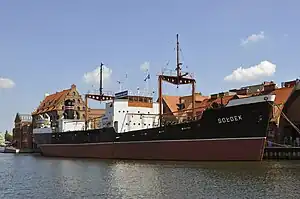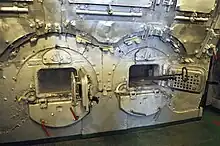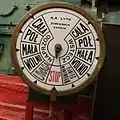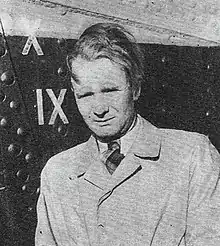 SS Sołdek as a museum ship in Gdansk | |
| History | |
|---|---|
| Name | SS Sołdek |
| Namesake | Stanislaw Sołdek |
| Owner | Polska Żegluga Morska |
| Port of registry | Szczecin |
| Builder | Stocznia Gdańska |
| Laid down | 3 April 1948 |
| Launched | 6 November 1948 |
| In service | 21 October 1949 |
| Out of service | 30 December 1980 |
| Identification |
|
| Status | Established as a museum ship in Gdansk, 17 July 1985 |
| General characteristics | |
| Tonnage | |
| Length | 87 m (285 ft 5 in) |
| Beam | 12.3 m (40 ft 4 in) |
| Propulsion |
|
| Speed | 9.9 knots (18.3 km/h; 11.4 mph) |
| Crew | 28 |


SS Sołdek is a retired Polish coal and ore freighter. She was the first ship built in Gdańsk (Poland) after World War II and the first seagoing ship completed in Poland. She was the first of 29 ships classed as Project B30, built between 1949 and 1954 in Stocznia Gdańska (Gdańsk Shipyard). The name was given in honour of Stanisław Sołdek, one of the shipyard's shock workers.[2]
Sołdek is oftently mistaken with the SS Oliwa (a former unfinished Hansa A type cargo ship), which was commissioned after Sołdek,[3] however which's hull was already constructed in 1944. It was abandoned by the Germans on a slipway in Szczecin, and seized by Poland. Following this the hull was completed and the ship launched as Oliwa. Later she was renamed and entered service in 1951 as Marchlewski, serving the Polish Ocean Lines.[4] Many sources incorrectly state that Oliwa was Sołdek's makeshift name during her launch, and that she was later relaunched again as Sołdek.
The ship is currently preserved as a museum ship in Gdańsk, as a part of National Maritime Museum collection.[5]
The ship was used in the movie Persona Non Grata as a Japanese steamer transporting Jews from Vladivostok to Tsuraga.
Other B30 ships
Polish
- Sołdek (shipyard number B30/1)
- Jedność Robotnicza (B30/2)
- Brygada Makowskiego (B30/3)
- 1 Maj (B30/4) (sold to the USSR as Pervomaysk)
- Pstrowski (B30/5)
- Wieczorek (B30/6)
Built for the USSR
- (B30/7) - Zaporozhe
- (B30/8) - Krivoy Rog
- (B30/9) - Kramatorsk
- (B30/10) - Makeevka
- (B30/11) - Gorlovka
- (B30/12) - Novo- Shahtinsk
- (B30/13) - Solikamsk
- (B30/14) - Kurgan
- (B30/15) - Zlatoust
- (B30/16) - Minusinsk
- (B30/17) - Pavlodar
- (B30/18) - Jenakiyevo
- (B30/19) - Nikitovka
- (B30/20) - Novocherkassk
- (B30/21) - Volnovacha
- (B30/22) - Vitegra
- (B30/23) - Tovda
- (B30/24) - Kalar
- (B30/25) - Azovstal
- (B30/26) - Tkvarcheli
- (B30/27) - Zangenzur
- (B30/28) - Malaia Zemlia
- (B30/29) - Pereyeslav Khmielnitsky
A number of B-30 ships saw service for the Soviet Navy, as auxiliary vessels (e. g. transports), including the "Tovda" and the "Vitegra". Corresponding data (including side plan) can be found i. a. in Weyer's Flottentaschenbuch 1971/72.
References
- ↑ "SOLDEK". shipspotting.com. Retrieved 18 December 2012.
- ↑ "History of the ship". Polish Maritime Museum. Archived from the original on 10 November 2013. Retrieved 18 December 2012.
- ↑ Strefa Historii (Polish)
- ↑ Fleet of Polish Ocean Lines: Marchlewski
- ↑ "SS Sołdek". Polish Maritime Museum. Archived from the original on 26 January 2013. Retrieved 18 December 2012.










